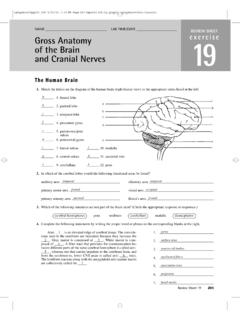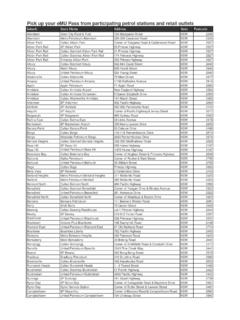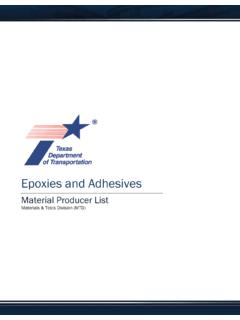Transcription of SPINE Volume 35, Number 21, pp 1919–1924 ©2010, …
1 SPINE Volume 35, Number 21, pp 1919 1924. 2010, Lippincott Williams & Wilkins qualitative grading of severity of Lumbar Spinal Stenosis Based on the Morphology of the Dural Sac on Magnetic Resonance Images Constantin Schizas, MD, PD, FRCS,* Nicolas Theumann, MD, PD, Alexandre Burn, MD,*. Rosamond Tansey, MD,* Douglas Wardlaw, FRCS, Francis W. Smith, MD, . and Gerit Kulik, PhD*. Study Design. Retrospective radiologic study on a pro- resulted in overdiagnosis of stenosis in 35 patients and spective patient cohort. under diagnosis in 12. No relation could be found be- Objective. To devise a qualitative grading of lumbar tween stenosis grade or DSCA and baseline Oswestry spinal stenosis (LSS), study its reliability and clinical rel- Disability Index or surgical result. C and D grade patients evance.
2 Were more likely to fail conservative treatment, whereas Summary of Background Data. Radiologic stenosis is grades A and B were less likely to warrant surgery. assessed commonly by measuring dural sac cross-sec- Conclusion. The grading defines stenosis in different tional area (DSCA). Great variation is observed though in subjects than surface measurements alone. Since it surfaces recorded between symptomatic and asymptom- mainly considers impingement of neural tissue it might atic individuals. be a more appropriate clinical and research tool as well as Methods. We describe a 7-grade classification based carrying a prognostic value. on the morphology of the dural sac as observed on T2 Key words: lumbar spinal stenosis, magnetic reso- axial magnetic resonance images based on the rootlet/ nance imaging, SPINE decompression, conservative treat- cerebrospinal fluid ratio.
3 Grades A and B show cerebro- ment, classification. SPINE 2010;35:1919 1924. spinal fluid presence while grades C and D show none at all. The grading was applied to magnetic resonance im- ages of 95 subjects divided in 3 groups as follows: 37 Lumbar spinal stenosis (LSS) is diagnosed in an ever in- symptomatic LSS surgically treated patients; 31 symp- creasing Number of patients referred to spinal surgeons tomatic LSS conservatively treated patients (average fol- for treatment as a result of the availability of magnetic low-up, and years); and 27 low back pain (LBP). sufferers. DSCA was also digitally measured. We studied resonance imaging (MRI) and ageing of the population. intra- and interobserver reliability, distribution of grades, Radiologic LSS might not always be the cause of the relation between morphologic grading and DSCA, as well presenting symptoms since it can to a certain degree be relation between grades, DSCA, and Oswestry Disability present in asymptomatic ,2 Several parameters Index.
4 Have been proposed in defining spinal stenosis, the pre- Results. Average intra- and interobserver agreement was substantial and moderate, respectively (k and vailing being measurements of spinal canal or dural sac ), whereas they were substantial for physicians work- cross-sectional surface area (DSCA) in either computed ing in the study originating unit. Surgical patients had the tomography (CT) or axial MRI sequences taken at disc smallest DSCA. A larger proportion of C and D grades was level. Surfaces measuring less than 100 mm2 or 75 mm2. observed in the surgical group. Surface measurements represent respectively relative and absolute A. significant variation in surface measurements is found though with overlapping of symptomatic and asymp- From the Departments of *Orthopedics and Radiology, Centre Hos- tomatic patient numerical In an effort to counter pitalier Universitaire Vaudois (CHUV), University of Lausanne, Lau- the above limitations other parameters have been devel- sanne, Switzerland; NHS Grampian, Orthopaedic Unit, Woodend oped such as the stenosis ratio (SR).
5 5 In addition to Hospital, Aberdeen, Untied Kingdom; and Centre for Spinal Re- search, Positional MRI Centre, Woodend Hospital, Aberdeen, United showing poor correlation with clinical symptoms,1,6,7. Kingdom. the above-mentioned quantitative parameters require ac- Acknowledgment date: September 21, 2009. Revision date: December curate measurement using tools not always available in 19, 2010. Acceptance date: January 7, 2010. The manuscript submitted does not contain information about medical everyday clinical practice. device(s)/drug(s). In an effort to improve the currently available radio- No funds were received in support of this work. Although one or more logic LSS criteria, we designed a qualitative grading sys- of the author(s) has/have received benefits for personal or professional use from a commercial party related directly or indirectly the subject of tem based on the morphologic appearance of the dural the manuscript, benefits will be directed solely to a research fund, sac as seen on T2-weighted axial images of the lumbar foundation, educational institution, or other non-profit organization SPINE , taking into account the cerebrospinal fluid (CSF)/.
6 Which the author(s) has/have been associated. Supported by research funds (unrestricted grant) from DePuy SPINE rootlet content. Switzerland (to the Department of Orthopedics). Local Ethics committee approval granted (IRB). Materials and Methods Address correspondence and reprint requests to Constantin Schizas, MD, PD, FRCS, Orthopedic Department, Centre Hospitalier Universitaire This was a retrospective radiologic study coupled with data Vaudois (CHUV), University of Lausanne, Avenue Pierre-Decker 4, CH- from a prospective LSS patient database. Institutional review 1011 Lausanne, Switzerland; E-mail: board approval was granted for this study. 1919. 1920 SPINE Volume 35 Number 21 2010. A total of 95 patients were included in this study. They were comprised of 3 groups as follows: surgically treated LSS pa- tients (n 37 patients), conservatively treated LSS patients (n 31 patients), and low back pain sufferers (LBP group, n.)
7 27 patients). All surgical and conservative group patients (n 68) were consecutive cases referred to our clinic with neurologic claudi- cation and MRI studies available in the Pictures Archiving and Communication System of our institution demonstrating vary- ing degrees of spinal stenosis. All surgical group patients failed at least 6 months of conservative treatment, including oral an- algesia, physiotherapy, and epidural steroids. Conservative group patients were treated using a mixture of the above- mentioned methods. None of the conservative group patients required surgery during at least a 12-month period. Duration of symptoms before referral in our clinic was of (standard deviation [SD], ) months in the surgical group and (SD, ) months for the conservative group. Average follow- ups of the conservative and surgical groups were years (SD, ) and years (SD, ), respectively.
8 LBP group patients were consecutive cases referred for spinal MRI in our institu- tion and suffering from LBP either nonspecific, due to degener- ative disc disease or to an inflammatory spondyloarthropathy. Suspected spinal stenosis cases were excluded from this group with none of those reporting radicular symptoms or neurologic claudication. The LBP group patients were not included in the clinical outcome part of the study, and therefore no follow-up was performed. Average age was years (SD, ) in the surgical group, years (SD, ) in the conservative group and years (SD, ) in the LBP group of patients. Thirty-six were males and 59 were females. The female/male ratio was , , and in the surgical, conservative, and LBP groups, respectively. The proportion of patients presenting degenerative spon- dylolisthesis at any level was not significantly different between the surgical and conservative groups, although the surgical group had more subjects with L4 L5 spondylolisthesis (19 in the surgical group and 7 in the conservative group).
9 No LBP. patient presented a spondylolisthesis. Surgery consisted of decompression in all cases, associated Figure 1. Description of the morphologic classification of spinal with instrumented fusion in 24 patients mainly due to the pres- stenosis combining graphic and MRI examples. ence of degenerative spondylolisthesis. Sagittal T1-weighted spin-echo, sagittal T2-weighted fast spin-echo, and axial T2-weighted fast spin-echo lumbar SPINE A3: the rootlets lie dorsally and occupy more than half of images were acquired by using magnets operating at field the dural sac area. strength of T, with a section thickness and a A4: the rootlets lie centrally and occupy the majority of the intersection gap. The field of view was 31 31 cm for dural sac area. sagittal images and 18 15 cm for axial images.
10 The images Grade B stenosis: the rootlets occupy the whole of the dural were collected electronically and stored directly as Digital Im- sac, but they can still be individualized. Some CSF is still aging and Communications in Medicine files. All available present giving a grainy appearance to the sac. MRI studies were accepted irrespective of the quality of the Grade C stenosis: no rootlets can be recognized, the dural obtained images. sac demonstrating a homogeneous gray signal with no CSF. The grading is based on the CSF/rootlet ratio as seen axial signal visible. There is epidural fat present posteriorly. T2 images and was conceived following observation of the Grade D stenosis: in addition to no rootlets being recogniz- different patterns according which the rootlets were disposed able there is no epidural fat posteriorly.






